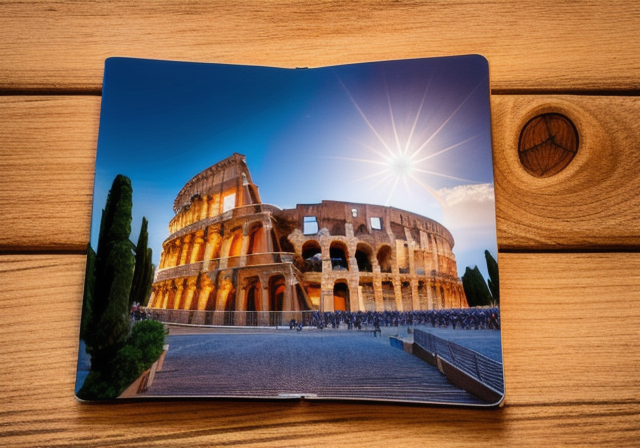Introduction
Italy is renowned for its rich artistic heritage, spanning centuries of creativity and innovation. From the intricate sculptures of the Renaissance to the soaring operas of Verdi, Italian art and music have captivated audiences around the world. The country’s unique cultural landscape has often been described as a melting pot, a place where different styles, traditions, and techniques come together in a harmonious blend that is both timeless and contemporary.
Throughout history, Italian artists and musicians have challenged the status quo, pushing the boundaries of what was possible and creating new forms of expression that have inspired generations. From the iconic works of Michelangelo to the heart-wrenching melodies of Puccini, Italian art and music have left an indelible mark on the world’s cultural heritage. It is no wonder that millions of people flock to Italy every year to experience firsthand the magic of this enchanting world.
The Renaissance: A Golden Age of Art and Music
The Renaissance was a period of great artistic and cultural flourishing that spanned from the 14th to the 17th century. During this time, Italy was the epicenter of an artistic revolution that saw the emergence of some of the most iconic figures in Western art history, such as Leonardo da Vinci, Michelangelo, and Raphael. The Renaissance was also a golden age of music, with composers like Palestrina and Monteverdi creating works that are still performed today.
One of the most remarkable features of the Renaissance was the close relationship between art and music. Many of the great masterpieces of the time, such as Michelangelo’s Sistine Chapel ceiling and Da Vinci’s Last Supper, were created in collaboration with musicians and composers who provided the inspiration and musical accompaniment for these works.
The Opera: A Unique Italian Art Form
The opera is a unique form of musical theater that originated in Italy in the 17th century. It combines music, drama, and visual arts to create a powerful and emotional experience that has captivated audiences for centuries. Some of the most renowned operas in the world, such as Verdi’s La Traviata and Puccini’s Madame Butterfly, were written by Italian composers.
One of the most interesting features of the opera is the use of recitative, a type of singing that mimics the natural rhythms of speech. Recitative is used to advance the plot and convey dialogue, while the more lyrical and expressive arias are used to express emotions and feelings. This unique approach to musical storytelling has made the opera a beloved art form around the world.
Join us on a journey through this enchanting world, as we explore the history, traditions, and beauty of Italian art and music. From the Renaissance to the opera, we will delve into the fascinating stories, curious details, and less-known facts that make Italian art and music so special. Whether you are an art aficionado or a music lover, there is something for everyone in this captivating world.
Italian Art: A Journey Through Centuries of Creativity and Innovation
Italy is home to some of the world’s most renowned and influential artists, whose works have inspired generations of creatives across the globe. Italian art has had a profound impact on the world of art and culture, with its influence felt in everything from painting and sculpture to architecture and fashion. The rich artistic heritage of Italy spans centuries of creativity and innovation, and continues to captivate audiences around the world.
The Renaissance: Masterpieces of Art and Architecture
The Renaissance was a period of great artistic and cultural achievement in Italy, and many of its masterpieces continue to inspire and awe audiences today. From the iconic ceiling of the Sistine Chapel to the breathtaking David sculpture, the Renaissance produced some of the most recognizable and celebrated works of art in the world.
Fun Fact: Michelangelo’s David was originally intended to be placed on the roof of the Florence Cathedral, but was eventually placed in the Piazza della Signoria, where it has stood for over 500 years.
Explore the works of Caravaggio, Botticelli, and Leonardo da Vinci, and learn about their techniques and inspirations. Leonardo da Vinci’s Mona Lisa is perhaps the most famous painting in the world, renowned for its mysterious smile and enigmatic gaze. But did you know that da Vinci was also a prolific inventor and engineer, and designed everything from flying machines to war machines?
Italian Modern Art: From Futurism to Contemporary Works
Italian modern art is just as diverse and innovative as its Renaissance counterparts, with movements such as Futurism and Arte Povera challenging traditional notions of art and beauty. The Futurist movement, founded by Filippo Tommaso Marinetti in 1909, celebrated the speed, dynamism, and energy of modern life, and sought to capture it in their art.
Fun Fact: Futurist artist Umberto Boccioni’s sculpture Unique Forms of Continuity in Space depicts a figure in motion, and is considered one of the most important works of modern sculpture.
Contemporary Italian artists such as Maurizio Cattelan and Francesco Vezzoli continue to push boundaries and challenge conventions, creating works that are thought-provoking and engaging. Cattelan’s provocative sculptures often use humor and irony to comment on contemporary society, while Vezzoli’s work blurs the line between art and celebrity culture.
Conclusion
Italian art is a testament to the creativity, innovation, and passion of its artists, whose works continue to captivate and inspire audiences around the world. From the masterpieces of the Renaissance to the cutting-edge contemporary works of today, Italian art is a rich and diverse tapestry that reflects the beauty and complexity of the human experience.
Italian Music
Just like Italian art, Italian music has a rich history that has captivated audiences for centuries. From opera to classical music to folk traditions, Italy has produced some of the world’s most beloved composers and performers.
Opera and Classical Music
Italian opera and classical music have had a profound impact on the world of music, with composers such as Antonio Vivaldi, Giuseppe Verdi, and Giacomo Puccini creating some of the most iconic pieces of music in history. Vivaldi, known as the “Red Priest,” wrote more than 500 concertos and is best known for his Four Seasons. Verdi is considered one of the greatest opera composers of all time, with works like La Traviata and Aida still performed around the world. Puccini is known for his operas, including La Bohème and Madame Butterfly, which have become some of the most popular and beloved works in the genre.
Folk Music
Italian folk music is just as captivating as its classical counterpart, with a range of regional styles and traditions. From the haunting melodies of the tarantella to the lively rhythms of the saltarello, Italian folk music has a rich history that is deeply tied to the country’s culture and heritage. The tarantella is a traditional dance that originated in southern Italy and is often accompanied by lively music played on instruments such as the accordion and tambourine. The saltarello, on the other hand, is a dance that originated in central Italy and is typically performed to the beat of a fast-paced, lively tune played on instruments such as the guitar and mandolin.
Modern Pop and Rock
No discussion of Italian music would be complete without a look at modern Italian pop and rock. From the iconic songs of Mina to the chart-topping hits of Eros Ramazzotti and Laura Pausini, Italian pop and rock have made a significant impact on the music world. Mina is one of Italy’s most famous singers, known for hits like “Se Telefonando” and “Brava.” Ramazzotti burst onto the scene in the 1980s and has since become one of the country’s most successful musicians, with hits like “La Cosa Mas Bella” and “Un’Emozione Per Sempre.” Pausini, meanwhile, is one of Italy’s most popular female singers, with hits like “La Solitudine” and “Strani Amori.”
Italian music is a rich and diverse art form that has had a profound impact on the world of music and culture. From classical opera to traditional folk music to modern pop and rock, Italy has a musical tradition that is as captivating as its art and cuisine.
Italian Culture: Art, Design, Fashion, and More
Italian art and music are deeply intertwined, with each form of expression reflecting the traditions, history, and values of the Italian people. But Italy’s rich cultural heritage extends far beyond music and art, encompassing everything from food and wine to architecture, design, and fashion. Let’s take a closer look at some of the highlights of Italian culture.
Customs and Traditions
One of the most captivating aspects of Italian culture is its vibrant calendar of festivals and celebrations, many of which have been passed down through generations. From the colorful pageantry of Carnevale in Venice to the religious processions of Holy Week in Rome, these events provide a fascinating insight into the customs and traditions of the Italian people. Italy is also renowned for its delectable cuisine, with each region offering its own unique blend of flavors and ingredients. From the hearty pasta dishes of the south to the delicate seafood of the coast, Italian food is a true feast for the senses.
Architecture and Landmarks
Italy is home to some of the world’s most iconic landmarks, from the ancient ruins of Rome to the towering cathedrals of Florence. The country’s architecture reflects its rich history and cultural diversity, with styles ranging from Romanesque and Gothic to Baroque and Renaissance. One of the most famous examples of Italian architecture is the Colosseum, an enormous amphitheater in the heart of Rome that dates back to the first century AD. The Leaning Tower of Pisa is another must-see attraction, with its iconic tilt drawing visitors from around the world.
Design and Fashion
Italy is renowned for its sleek and stylish designs, from the elegant furniture of Milan to the fashion houses of Florence. Italian fashion has been a global trendsetter for decades, with designers such as Giorgio Armani, Gucci, and Prada leading the way. Italian design is also reflected in the country’s sleek and modern architecture, from the glass-and-steel skyscrapers of Milan to the futuristic structures of Rome’s EUR district.
Join us on a journey through the beauty and wonder of Italian culture, from its art and music to its customs, traditions, and landmarks. Discover the captivating world that has inspired generations of artists, designers, and music lovers.
If you want to learn more about Italian culture, check out our frequently asked questions below:
What is the origin of the tarantella?
The tarantella is a lively folk dance that originated in southern Italy. It was traditionally performed to cure the bite of the tarantula spider, which was believed to cause a form of hysteria known as tarantism.
What is the significance of the Venetian mask?
The Venetian mask is a traditional symbol of Carnevale, the pre-Lenten festival that takes place in Venice each year. Masks were originally worn as a way to allow people to mingle anonymously during the festival.
With its rich history, vibrant traditions, and stunning landscapes, Italy is a cultural treasure trove that never fails to captivate and inspire.



